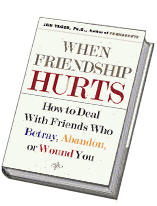
|



From WHEN FRIENDSHIP HURTS by Jan Yager,
Ph.D. Copyright � 2002 by Jan Yager. Reprinted by permission
of Fireside Books/Simon & Schuster, Inc.
The Reading Group Guide that follows is the same guide that is included in When Friendship Hurts. This Reading Group Guide
may be duplicated and distributed to Reading Groups, Book Clubs, or other groups that have chosen to read and discuss When
Friendship Hurts. You may purchase When Friendship Hurts at your favorite local or online bookstore. Community public, college
and graduate school, corporate, wellness, and self-help libraries may also have copies available for loan. (You might want to
request that they order the book if it is not yet available.)
Discussion Points:
- In When Friendship Hurts, Dr. Yager lists many possible reasons one friend might hurt another. Think of a friendship you care about that
either has ended or needs to improve if it is to last. What concepts from When Friendship Hurts might explain the conflicts in this
friendship and help you to mend it?
- What is the definition of a positive friendship? What does Dr. Yager say are the key components of friendships that reaffirm us?
- Dr. Yager writes that there are really three kinds of friendship: casual, close, and best. What is similar and what is contrasting in these
three categories?
- In addition to the level of intimacy involved, friendships are distinguish ed by the number of people in the friendship group. How do
friendships between two vary from friendship groups including three, four, or more?
- Dr. Yager suggests 21 different types of potentially negative friends. Do you recognize any of those traits in your current or former
friends? In yourself? Pick a type that describes one of your friends. Why do you think your friend is like that? What can you do, if
anything, to help yourself and your friend so the friendship stays positive?
- How can Dr. Yager's description of the Ideal Friend serve as a prototype? Do you have at least one friend who is ideal? Are you? In all
your friendships or only in certain ones? If you are not the Ideal Friend, what could you change about yourself so you are a better friend?
- How can the techniques of conflict resolution discussed in Chapter 5 apply to the conflict you may be having with a friend? Is there at
least one technique you could try next time a conflict arises with a friend?
- When, if ever, is it time to end a friendship? Why is it sometimes better to let a friendship fade than to have a dramatic
confrontation?
- What might you do if you don't like your child's friend? When might you want to intervene? What are other options to explore?
- What is the answer to the question posed by Chapter 7, "Friendship at Work: Are the Rules Different?" Should friendship at work be
encouraged? What are the benefits of workplace friendships? What are some of the potential drawbacks?
- In the final chapter, Dr. Yager shares the example of Doris and her two close friends, each of whom abruptly and inexplicably cut off
contact with her. What do you think of the way Doris handled this situation? Has something like that ever happened to you? How did you
handle it? Have you ever cut off contact with someone you had considered a friend? Why? How do you feel about that decision now?
- If you had to pick one concept from When Friendship Hurts that will be most helpful to you in the way you deal with betrayal in
friendship, or the way you approach friendship in your career or personal life, what would it be?
A Note to Readers
My goal in writing When Friendship Hurts was to inspire dialogue about an important relationship we usually take for granted. We know we
are supposed to work on our relationships with our spouses and children, but we seldom think of working on relationships with our friends.
Yet a true friendship can be one of life's most rewarding experiences, and I am convinced it is a relationship we should value highly.
Since, by definition, friendship requires more than one person, and since the feelings and memories that reading this book evoke may be
powerful and perhaps even painful, you may want some company on your journey.
Discussing these issues with a reading or support group may be an excellent way to explore the broad range of themes presented here.
But please remember that this book is not intended to substitute for professional help, if that is what you need. If you are already in
therapy, you might want to share this book with your therapist or group so that you can talk about your reactions to the topics,
anecdotes, and examples you are reading. Most of all, I hope this book will act as a catalyst to help you find your own answers.
My web site address is:
http://www.janyager.com.
There you will find information about my
research and writings, as well as information about the seminars I conduct. My other web site address is:
http://www.janyager.com/friendship. You will also learn about the annual National
New Friends, Old Friends Week, which I founded in 1997,
http://www.janyager.com/friendship/nationalnew-oldfriendsweek.htm,
celebrated for a week in May, to help remind all of us that friendships, especially positive and affirming ones, are worth remembering and
celebrating.
|
 |
|





